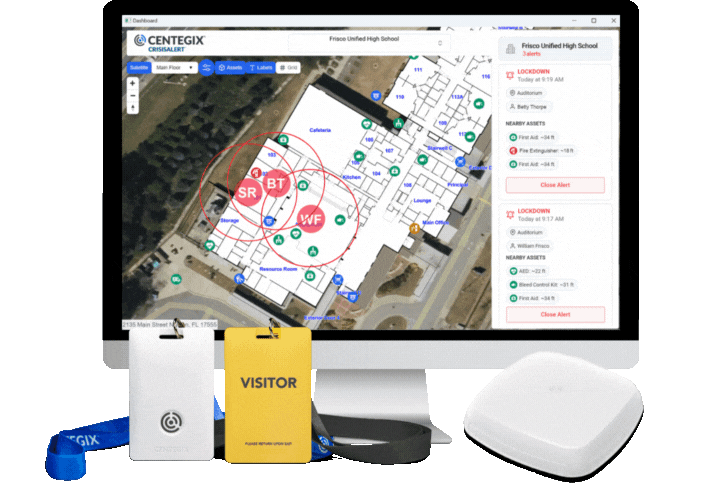Healthcare workers are burned out. They face a barrage of challenges every time they walk through the doors of hospitals and health clinics. Workplace violence tops the list of concerns among healthcare providers, who are five times more likely to sustain a workplace violence injury than those in other professions.
However, when clinics and hospitals support their staff with layers of safety policies, protocols, and technology, they help reduce violence in healthcare. These efforts are a powerful investment in their employees’ mental health.
Risk Factors for Workplace Violence in Healthcare
Nearly half of healthcare workers (46%) reported often feeling burned out in 2022, up from 32% in 2018. Furthermore, roughly half (44%) also intended to look for a new job in 2022. These trends continued throughout 2023. Stress levels and workplace violence negatively impact workers’ job satisfaction and willingness to continue in the profession.
According to the Centers for Disease Control and Prevention (CDC), healthcare workers face daily stressors, including exposure to infectious diseases and violence from patients and their families. The COVID-19 pandemic compounded these stressors in ways that impacted workers’ mental health:
- Patient surges made hospitals and clinics busier.
- Healthcare providers were obligated to work longer hours.
- Clinics and hospitals experienced supply shortages, including for protective equipment.
- Staffing shortages and patient stress resulted in higher rates of violence in healthcare.
As a result, healthcare workers report feeling fatigue, loss, and grief at levels higher than before the pandemic. Patients in these environments also experience higher stress levels, which can lead to tense and even violent incidents in healthcare environments.
Risk factors for workplace violence in healthcare settings include unpredictable behavior among patients and families who are under emotional stress and the following systemic factors:
- high-stress work environments
- staff shortages
- a lack of organizational policies
- a lack of staff training
- overcrowding
- long wait times
- inflexible visiting hours
- miscommunications
Organizational Strategies Improve Mental Health
Administrative interventions can make a meaningful difference in healthcare workers’ mental health. When healthcare employees work in supportive environments, they report having fewer mental health issues. Healthcare industry employers can intervene to improve the workplace in several specific ways:
- Include workers in decision-making
- Assign a senior leader to promote staff well-being
- Train supervisors to provide support
- Ensure adequate staffing
- Value worker safety and health
- Model and support taking time off
Each of these recommendations supports staff’s sense of autonomy and support. When leadership prioritizes and models mental health care as a fundamental element of the workplace, healthcare workers experience improved outcomes.
The Role of Safety in Improving the Healthcare Workplace
Overall, stress prevention is critical to preventing burnout among healthcare workers. The levels of stress associated with consistently feeling unsafe are very high, and they contribute to staffing shortages. According to a 2024 National Nurses United (NNU) report, 19% of nurses reported they changed or left their jobs due to workplace violence and 37% considered leaving the profession entirely.
The NNU asserts that healthcare employers’ failure to implement effective prevention strategies is exacerbating the staffing crisis and recommends a comprehensive workplace violence prevention standard. By making workers’ safety and mental health a high priority, healthcare workplaces can prevent violence, support employees, and make progress toward improving staffing and retention.
Increased focus on healthcare workplace safety is making a difference. In a recent poll of emergency nurses, respondents showed an improvement in their job satisfaction as a result of stronger safety measures, including:
- de-escalation training
- the establishment of response teams
- clearly stated public policies
- flagging concerns in EHRs
According to the workers, a holistic approach to workplace safety improves their sense of safety and positively impacts their mental health.
How to Create a Culture of Safety in the Healthcare Workplace
Leadership’s commitment to safety is critical to developing a safety culture within an organization. Hospital and clinic administrators should work to create systems that improve safety and security and prioritize employees’ mental health.
By building mental health measures into ongoing safety efforts, healthcare workplaces create a culture of safety that supports employees. The CDC offers guidance to healthcare employers about actions they can take to impact employees’ well-being positively. The first action prescribed is to “Review Your Hospital’s Operations” by connecting with colleagues to gather information about current efforts that support healthcare worker well-being. These might include establishing clear reporting procedures, providing guidance for employees seeking mental healthcare, and creating a mental healthcare team to support employees. Workplace quality improvement initiatives should include violence and harassment prevention plans and policies to ensure adequate staffing.
CENTEGIX Technology: Foundational to a Safer Healthcare Workplace
Healthcare employers can lower employee stress levels by implementing safety measures and policies that decrease instances of workplace violence. They can further improve employees’ job satisfaction by communicating how these measures improve safety and make mental health support fundamental to employees’ experience.
CENTEGIX technology empowers healthcare employers to cultivate a culture of safety. The CENTEGIX Safety Platform™ supports organizations in ensuring that healthcare staff feel safe at work. As the foundation of a layered safety plan, CENTEGIX Safety Platform facilitates the fastest response to emergencies. Its features include:
- an easy-to-use wearable duress button for all staff
- dynamic digital mapping of the facility
- incident-activated locating capabilities
- a visitor management system
The Safety Platform leverages innovative technology to surround employees with layers of safety that provide peace of mind. By investing in CENTEGIX technology, organizations are investing in their employees’ physical and mental well-being.
CENTEGIX CrisisAlert™
CrisisAlert is a discreet and wearable duress button for healthcare workers. When staff members feel unsafe or encounter an escalating situation, they can quickly and discreetly request assistance from designated responders. These alerts set safety protocols into motion. Therefore, employees know that they will receive immediate support when they need it.
CENTEGIX CrisisAlert offers:
- Discreet, wearable duress buttons for all staff; every employee is protected.
- Campus-wide coverage: employees can request help from anywhere on campus, indoors or outdoors, and in parking garages.
- A private, managed Bluetooth network: support is immediately alerted, regardless of Wi-Fi or cellular connectivity.
- Precise location information: responders and administrators can see the exact location and person summoning help.
CENTEGIX Safety Blueprint™
CENTEGIX’s dynamic digital mapping technology provides critical information that accelerates emergency response. The CENTEGIX Safety Blueprint map displays the location of safety assets, making them visible to employees and responders.
In addition, Safety Blueprint empowers healthcare employers to do the following:
- define and customize safety plans
- quickly disseminate campus information
- Add and edit assets on maps in real time
- centralize safety information for key personnel accessibility
CENTEGIX Visitor Management
Providers interact with patients and their stressed family members in healthcare environments. This increases the opportunity for escalated incidents and violence. Other visitors, including contractors and visiting staff, enter healthcare facilities every day. CENTEGIX Enhanced Visitor Management checks in and screens all visitors before they enter and can locate them during their stay, giving employers and staff confidence that the people they encounter on campus are permitted to be there. By adding this layer of safety, healthcare employers indicate their investment in providers’ sense of safety and well-being.
Request a demo today to learn more about how CENTEGIX can help you create a culture of safety in your hospital or clinic.












